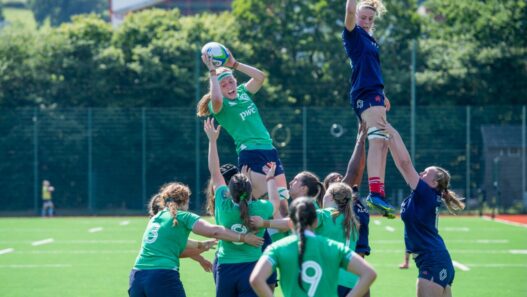Gymnastics has always been one of the most popular Olympic sports by viewership. Whether you think of Comaneci and her first Olympic perfect 10 or the powerhouse that is Simone Biles, the style of the sport has changed but the appeal has endured.
But how exactly does one compete? How are the gymnasts scored? Here’s our guide to women’s artistic gymnastics.
Apparatus
Vault
Have you ever wanted to run full speed at a stationary object? How about doing that, flipping over a table and landing without taking any steps? Welcome to vault.
The run up to the vault is 25m, with the vault table being 1.25m high. The goal is to place your hands on the table (formerly known as a horse) and get as much height off it as you can – this gives you time to do your tricks. Don’t worry though – you’ll have the help of a springboard to get onto the vault and a sprung surface on top of the vault table to help you.
The easiest vault one can do in competition is a handspring – essentially a front flip over the vault. From there, difficulty can be increased by adding twists or a roundoff in the first flight (before your hands touch the vault) and/or adding twists or somersaults (or both!) in the second flight (before you touch the ground again).
When landing, you must land in a marked area on the mat – taking no extra steps – or you will lose points. The more difficult the vault, the harder it is to land this way. Vault is also judged on how high you get coming off the vault and how far away from it you land. Generally, the more powerful the gymnast, the nicer the vault looks in the air. But remember, more power can make it harder to land!

Uneven Bars
This apparatus became a worldwide favourite after Comaneci’s perfect 10 in the 1976 Olympics. However, the style of movement we see now is very different to that of forty years ago.
Prior to the ‘80s, the bars – one low and one high – were placed quite close to each other. This allowed for more circle skills close to the bar and daredevil tricks involving hitting one’s hips against the low bar, oftentimes from a handstand on the high bar.
Since then, the bars have been moved further apart, and with it we have seen more aerial release skills (where the gymnast lets go of the bar, performs a somersault or other skill and catches it again) and more difficult dismounts involving multiple somersaults and twists.
A good bar routine will have many different skills, but the minimum requirements are:
- A bar change from high bar to low bar – the gymnast must let go and fly down to the low bar, normally catching it in a handstand.
- A flight element on the same bar – this is the release skill we spoke about earlier, where the gymnast lets go of the bar, does a somersault, and catches the same bar again.
- At least two different grips. The majority of most routines are performed with a regular grip – how most people would naturally hold a bar when hanging – but at least one skill must be done holding the bar differently. A 360° turn. This is normally performed in a handstand.
Many gymnasts find the uneven bars to be harder than the other apparatus. This is because vault, beam and floor share many of the same skills, whereas the movements you see on bars are more unique. As such, gymnasts who medal on bars tend to be bar specialists, and do not medal on multiple apparatus as much as vault, beam or floor specialists.

Beam
The piece that is terrifying to most, it is 1.25m off the floor and only 4.5 inches wide. Gymnasts are required to show acrobatic skills (cartwheels, flips, somersault etc.) and gymnastics skills (jumps, leaps, spins) and tie it all together with choreography. On beam, style and grace are rewarded, as well as the difficulty and execution of your skills.
The style of the routine is called artistry and we will see this also on floor. In recent years, the International Gymnastics Federation (FIG) has been encouraging more artistry on beam by requiring gymnasts to have three connected sideways movements on the beam and a movement close to the beam, as well as showing confidence, personal style, and variation in rhythm and tempo. Oh, and with all of that, your routine must be under 90 seconds!
However, it may not matter how difficult and stylish your routine is if you fall – each fall carries a 1.00 mark deduction! On top of that, you can lose more marks if you don’t get back on the beam on time.

Floor
Probably the piece of apparatus most associated with the sport, floor, like beam, combines artistry with gymnastics skills. The main difference is that floor routines are performed to music. Music is chosen in accordance with the gymnast’s personality and dance ability, and the gymnast must relate their performance to the music. The performance cannot exceed 90 seconds and there are no lyrics allowed in the music.
The routine is performed on a sprung floor 12m x 12m. Gymnasts must use all areas of the floor, but generally will use the diagonal to perform their powerful tumbling passes. Like the beam, gymnasts must also perform some of the exercise low down on the floor.
Deductions are taken specifically on floor if the gymnast steps “out of bounds” i.e. if one or two legs go across the marked line. Gymnasts can also lose marks if their movements do not match up to the music, particularly at the end.
In an all-around final, the group of gymnasts who scored highest in qualification will normally perform last on floor as it is quite the climactic event.

Calculation of Score
Every gymnast on every piece starts with an execution of score of 10.00. Any deviation from how her skills should be performed results in a deduction, which come in 0.1, 0.3, 0.5 and 1.00 increments – 0.1 being a small mistake and 0.5 a large one.
Mistakes that can be easily seen by the average spectator include taking steps on landing, bent arms or legs and falls which result in a 1.00 deduction on any apparatus.
This is the old system that most people are familiar with as it produced perfect 10’s.
In recent years, gymnasts have been rewarded for how difficult their routines are. This is known as the difficulty score (D-score) and is added to the execution score (E-score) to give the final score.
On vault, there is a set difficulty value for each vault ranging from 2.00 to 6.40.
On all other pieces, there are three parts to calculating the D-score: composition requirements, difficulty values and connection values.
Uneven bars, beam and floor each have four composition requirements for which gymnasts receive 0.5 each for performing, giving a total of 2.0 if all are performed.
For difficulty value, the top eight skills including the dismount (last acrobatic skill before getting off the apparatus) are counted. These skills are given a value A-I, with A being worth 0.1 and I being worth 0.9.
Gymnasts are also rewarded on uneven bars, beam, and floor for connecting certain difficult elements to each other, giving the connection value.
These are all added together to give the D-score.
Finally, we have neutral deductions. These result for example if a gymnast steps outside the border markings on floor or performs her beam routine for more than 90 seconds. Neutral deductions are only taken by the difficulty judge from the final score.
So, E-score + D-score – neutral deductions = gymnast’s score.
Competition
Qualification
This is the first round of any competition, where a given number of the highest scoring gymnasts and teams will progress to team, individual all around and event finals.
Team Final
The top 8 teams from qualification make it through to the team final.
In this event, a maximum of five gymnasts are allowed on a team. Four are allowed to compete on each piece of apparatus and the top three scores count towards the team total. That is, 3 scores on vault + 3 scores on bars + 3 scores on beam + 3 scores on floor. The team with the highest total wins.
All Around
Possibly the most coveted title, the individual all around champion is the gymnast who has the highest combined score of all four apparatus. 24 gymnasts qualify for this event but only two from any country are allowed to compete in the final. This is known as the “two per country rule”. So although USA had a 1-2-3 finish in qualifiers at the Rio Olympics with Biles, Raisman and Douglas, only Biles and Raisman could progress to the final.
Event Finals
The top 8 gymnasts on each apparatus head to event finals for that apparatus. This is where we see the big skills being performed!
Gymnasts will generally try to play it safer in qualification in order to make it to finals, and then bring out the big guns in event finals. This means upping their difficulty score, by either upgrading skills (performing a harder version of a skill), adding more difficult skills, or connecting difficult skills to receive connection value.
As only one routine counts in event finals, there is less room for error than in the team or all around finals.
Now that you are a gymnastics expert why not give it a go? Find a local club here.








